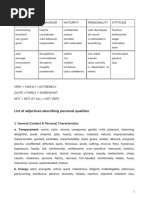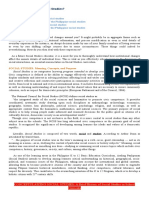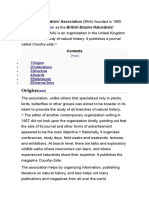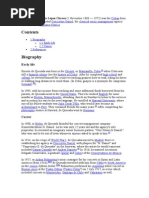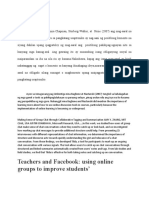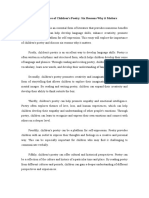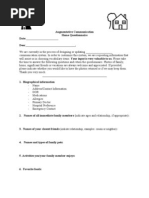Discipline (Academia) : From Wikipedia, The Free Encyclopedia
Discipline (Academia) : From Wikipedia, The Free Encyclopedia
Uploaded by
Fernán GaillardouCopyright:
Available Formats
Discipline (Academia) : From Wikipedia, The Free Encyclopedia
Discipline (Academia) : From Wikipedia, The Free Encyclopedia
Uploaded by
Fernán GaillardouOriginal Description:
Original Title
Copyright
Available Formats
Share this document
Did you find this document useful?
Is this content inappropriate?
Copyright:
Available Formats
Discipline (Academia) : From Wikipedia, The Free Encyclopedia
Discipline (Academia) : From Wikipedia, The Free Encyclopedia
Uploaded by
Fernán GaillardouCopyright:
Available Formats
Discipline (academia)
From Wikipedia, the free encyclopedia
(Redirected from Academic discipline)
"Academic discipline" redirects here. It is not to be confused with School discipline.
For a topical guide to this subject, see Outline of academic disciplines.
[hide]This article has multiple issues. Please help improve it
the talk page.
This article may require cleanup to meet Wikipedia's
2010)
This article has an unclear citation style. (September 2012)
An academic discipline is a branch of knowledge. It incorporates expertise, people,
projects, communities, challenges, studies, inquiry, and research areas that are strongly
associated with a given academic discipline. For example, the branches of science are
commonly referred to as the scientific disciplines, e.g. physics, mathematics, computer
science.
Individuals associated with academic disciplines are commonly referred to as experts or
specialists. Others, who may have studied liberal arts or systems theory rather than
concentrating in a specific academic discipline are classified asgeneralists.
While academic disciplines in and of themselves are more or less focused practices,
scholarly approaches such asmultidisciplinarity, interdisciplinarity, transdisciplinarity,
and crossdisciplinarity, integrate aspects from multiple academic disciplines, therefore
addressing any problems that may arise from narrow concentration within specialized fields
of study. For example, professionals may encounter trouble communicating across
academic disciplines because of differences in language and/or specified concepts.
Some researchers believe that academic disciplines may be replaced by what is known
as Mode 2[1] or "post academic science",[2] which involves the acquisition of crossdisciplinary knowledge through collaboration of specialists from various academic
disciplines.
Contents
[hide]
o
o
o
o
1History of the concept
2Functions and criticism
3Communities of academic disciplines
4Variations
4.1Multidisciplinary
4.2Interdisciplinary
4.3Transdisciplinary
4.4Cross-disciplinary
5Bibliometric studies of disciplines
6References
7Further reading
8External links
History of the concept[edit]
The University of Paris in 1231 consisted of four faculties: Theology, Medicine, Canon
Law and Arts.[3]
Educational institutions originally used the term "discipline" to catalog and archive the new
and expanding body of information produced by the scientific community. Disciplinary
designations originated in German Universities during the beginning of the nineteenth
century.
Most academic disciplines have their roots in the mid-to-late-19th century secularization of
universities, when the traditionalcurricula were supplemented with non-classical languages
and literatures, social sciences such as political science,economics, sociology and public
administration, and natural science and technology disciplines such
as physics, chemistry,biology, and engineering.
In the early 20th century, new academic disciplines such
as education and psychology were added. In the 1970s and 1980s, there was an explosion
of new academic disciplines focusing on specific themes, such as media studies, women's
studies, and black studies. Many academic disciplines designed as preparation for careers
and professions, such as nursing,hospitality management, and corrections, also emerged
in the universities. Finally, interdisciplinary scientific fields of study such
as biochemistry and geophysics gained prominence as their contribution to knowledge
became widely recognized.
As the twentieth century approached, these designations were gradually adopted by other
countries and became the accepted conventional subjects. However, these designations
differed between various countries.[4] In the twentieth century, the science disciplines
included: physics, chemistry, biology, geology, and astronomy. The social science
disciplines included: economics, politics, sociology, and psychology.
Prior to the twentieth century, categories were broad and general, which was expected due
to the lack of interest in science at the time. With rare exceptions, practitioners of science
tended to be amateurs and were referred to as "natural historians" and "natural
philosophers"labels that date back to Aristotleinstead of "scientists". [5] Natural history
referred to what we now call life sciences and natural philosophy referred to the current
physical sciences.
Few opportunities existed for science as an occupation outside of the educational system.
Higher education provided the institutional structure for scientific investigation, as well as
economic support. Soon, the volume of scientific information rapidly increased and people
realized the importance of concentrating on smaller fields of scientific activity. Because of
this, scientific specializations emerged. As these specializations developed, modern
scientific disciplines in universities also improved. Eventually, academia's identified
disciplines became the foundations for people of specific specialized interests and
expertise.[6]
Functions and criticism[edit]
A very influential critique of the concept of academic disciplines came from Michel
Foucault in his 1975 book, Discipline and Punish. Foucault asserts that academic
disciplines originate from the same social movements and mechanisms of control that
established the modern prison and penal system in 18th century France, and that this fact
reveals essential aspects they continue to have in common: "The disciplines characterize,
classify, specialize; they distribute along a scale, around a norm, hierarchize individuals in
relation to one another and, if necessary, disqualify and invalidate." (Foucault, 1975/1979, p
223.[7])
Communities of academic disciplines[edit]
Communities of academic disciplines can be found outside of academia within
corporations, government agencies, and independent organizations, where they take the
form of associations of professionals with common interests and specific knowledge. Such
communities include corporate think tanks, NASA, and IUPAC. Communities such as these
exist to benefit the organizations affiliated with them by providing specialized new ideas,
research, and findings.
Nations at various developmental stages will find need for different academic disciplines
during different times of growth. A newly developing nation will likely prioritize government
and political matters over those of the arts and sciences. On the other hand, a welldeveloped nation may be capable of investing more into the arts and sciences.
Communities of academic disciplines would contribute at varying levels of importance
during different stages of development.
Variations[edit]
These categories explain how the different academic disciplines interact with one another.
Multidisciplinary[edit]
Main article: Multidisciplinary approach
Multidisciplinary' knowledge is associated with more than one existing academic discipline
or profession.
A multidisciplinary community or project is made up of people from different academic
disciplines and professions. These people are engaged in working together as equal
stakeholders in addressing a common challenge. A multidisciplinary person is one with
degrees from two or more academic disciplines. This one person can take the place of two
or more people in a multidisciplinary community. Over time, multidisciplinary work does not
typically lead to an increase or a decrease in the number of academic disciplines. One key
question is how well the challenge can be decomposed into subparts, and then addressed
via the distributed knowledge in the community. The lack of shared vocabulary between
people and communication overhead can sometimes be an issue in these communities and
projects. If challenges of a particular type need to be repeatedly addressed so that each
one can be properly decomposed, a multidisciplinary community can be exceptionally
efficient and effective.[citation needed]
There are many examples of a particular idea appearing in different academic disciplines,
all of which came about around the same time. One example of this scenario is the shift
from the approach of focusing on sensory awareness of the whole, "an attention to the 'total
field'", a "sense of the whole pattern, of form and function as a unity", an "integral idea of
structure and configuration". This has happened in art (in the form of cubism), physics,
poetry, communication and educational theory. According to Marshall McLuhan, this
paradigm shift was due to the passage from the era of mechanization, which brought
sequentiality, to the era of the instant speed of electricity, which brought simultaneity.[8]
Multidisciplinary approaches also encourage people to help shape the innovation of the
future. The political dimensions of forming new multidisciplinary partnerships to solve the
so-called societal Grand Challenges were presented in the Innovation Union and in the
European Framework Programme, the Horizon 2020 operational overlay. Innovation across
academic disciplines is considered the pivotal foresight of the creation of new products,
systems, and processes for the benefit of all societies' growth and wellbeing. Regional
examples such as Biopeople and industry-academia initiatives in translational medicine
such as SHARE.ku.dk in Denmark provides the evidence of the successful endavour of
multidisciplinary innovation and facilitation of the paradigm shift. [citation needed]
Interdisciplinary[edit]
Main article: Interdisciplinarity
Interdisciplinary knowledge is the extent of knowledge that exists between or beyond
existing academic disciplines or professions. The new knowledge may be claimed by
members of none, one, both, or an emerging new academic discipline or profession.
An interdisciplinary community, or project, is made up of people from multiple disciplines
and professions who are engaged in creating and applying new knowledge as they work
together as equal stakeholders in addressing a common challenge. The key question is,
what new knowledge (of an academic discipline nature), which is outside the existing
disciplines, is required to address the challenge? Aspects of the challenge cannot be
addressed easily with existing distributed knowledge, and acquiring new knowledge
becomes a primary subgoal of addressing the common challenge. The nature of the
challenge, either its scale or complexity, requires that many people have interactional
expertise to improve their efficiency working across multiple disciplines as well as within the
new interdisciplinary area. An interdisciplinarian is a person with degrees and additional
interactional expertise from/in one or more academic disciplines, and new knowledge that
is claimed by more than one discipline. Over time, interdisciplinary work can lead to an
increase or a decrease in the number of academic disciplines. [citation needed]
Transdisciplinary[edit]
Main article: Transdisciplinarity
In practice, transdisciplinary can be thought of as the union of all interdisciplinary efforts.
While interdisciplinary teams may be creating new knowledge that lies between several
existing disciplines, a transdisciplinary team is more holistic and seeks to relate all
disciplines into a coherent whole.
Cross-disciplinary[edit]
Cross-disciplinary knowledge is that which explains aspects of one discipline in terms of
another. Common examples of cross-disciplinary approaches are studies of
the physics of music or the politics of literature.
Bibliometric studies of disciplines[edit]
Bibliometrics can be used to map several issues in relation to disciplines, for example the
flow of ideas within and among disciplines (Lindholm-Romantschuk, 1998) [9] or the
existence of specific national traditions within disciplines. [10] Scholarly impact and influence
of one discipline on another may be understood by analyzing the flow of citations. [11]
References[edit]
1.
Jump up^ Gibbons, Michael; Camille Limoges, Helga
Nowotny, Simon Schwartzman, Peter Scott, & Martin Trow
(1994). The New Production of Knowledge: The Dynamics of
Science and Research in Contemporary Societies. London:
Sage.
2.
Jump up^ Ziman, John (2000). Real Science: What It Is,
and What It Means. Cambridge: Cambridge University Press.
3.
Jump up^ History of Education, Encyclopdia Britannica
(1977, 15th edition), Macropaedia Volume 6, p. 337
4.
Jump up^ Jacques Revel (2003). "21". In Porter,
Theodore; Ross, Dorothy. Cambridge History of Science: The
Modern Social Sciences. Cambridge: Cambridge University
Press. p. 391-404. ISBN 0521594421.
5.
Jump up^ "How The Word 'Scientist' Came To
Be". npr.org. National Public Radio. Retrieved November
3, 2014.
6.
Jump up^ Cohen, E; Lloyd, S. "Disciplinary Evolution and
the Rise of Transdiscipline" (PDF). Informing Science: the
International Journal of an Emerging Transdiscipline,.
7.
Jump up^ Foucault, Michel (1977). Discipline and Punish:
The birth of the prison. Trans. Alan Sheridan. New York: Vintage.
(Translation of: Surveiller et punir; naissance de la prison.
[Paris] : Gallimard, 1975).
8.
Jump up^ "McLuhan: Understanding
Media". Understanding Media. 1964. p. 13. Archived from the
original on October 6, 2008.
9.
Jump up^ Lindholm-Romantschuk, Y. (1998). Scholarly
book reviewing in the social sciences and humanities. The flow
of ideas within and among disciplines. Westport, Connecticut:
Greenwood Press.
10.
Jump up^ Ohlsson, H. (1999). Is there a Scandinavian
psychology? A bibliometric note on the publication profiles of
Denmark, Finland, Norway, and Sweden. Scandinavian Journal
of Psychology, 40, 235239.
11.
Jump up^ Serenko, A. & Bontis, N. (2013). The
intellectual core and impact of the knowledge management
academic discipline.Journal of Knowledge Management, 17(1),
137-155.
Further reading[edit]
This article's further reading may not follow
Wikipedia's content policies orguidelines.
Please improve this article by removing excessive,
less relevant or many publications with the same
point of view; or by incorporating the relevant
publications into the body of the article through
appropriate citations. (August 2015)
R. Fagin, J. Y. Halpern, Y. Moses, and M. Y. Vardi. Reasoning about Knowledge,
The MIT Press, 1995. ISBN 0-262-56200-6
A. Abbott. The System of Professions: An Essay on the Division of Expert Labor,
University of Chicago Press, 1988. ISBN 978-0-226-00069-5
Augsburg, Tanya. (2005), Becoming Interdisciplinary: An Introduction to
Interdisciplinary Studies.
Dogan, Mattei & Pahre, R. (1990). "The fate of formal disciplines: from coherence
to dispersion." In Creative Marginality: Innovation at the Intersections of Social
Sciences. Boulder, CO: Westview. pp. 85113.
Dullemeijer, P. (1980). "Dividing biology into disciplines: Chaos or
multiformity?" Journal Acta Biotheoretica, 29(2), 8793.
Gibbons, M.; Limoges, C.; Nowotny, H.; Schwartzman,S.; Scott, P. & Trow, M.
(1994). The New Production of Knowledge: The Dynamics of Science and Research in
Contemporary Societies. London: Sage.
Golinski, Jan (1998/2005). Making Natural Knowledge: Constructivis, and the
History of Science. New York: Cambridge University Press.
Chapter 2: "Identity and discipline." Part II: The Disciplinary Mold (pp. 6678).
Hicks, Diana (2004). "The Four Literatures of Social Science". IN: Handbook of
Quantitative Science and Technology Research: The Use of Publication and Patent
Statistics in Studies of S&T Systems. Ed. Henk Moed. Dordrecht: Kluwer Academic.
Hyland, Ken (2004). Disciplinary Discourses: Social Interactions in Academic
Writing. New edition. University of Michigan Press/ESL.
Klein, J. T. (1990). Interdisciplinarity: History, Theory, and Practice. Detroit: Wayne
State University Press.
Leydesdorff, Loet & Rafols, Ismael. (2008). A global map of science based on the
ISI subject categories. Journal of the American Society for Information Science and
Technology. The decomposition of scientific literature into disciplinary and
subdisciplinary structures is one of the core goals of scientometrics. How can we
achieve a good decomposition? The ISI subject categories classify journals included in
the Science Citation Index (SCI). The aggregated journal-journal citation matrix
contained in the Journal Citation Reports can be aggregated on the basis of these
categories. This leads to an asymmetrical matrix (citing versus cited) that is much more
densely populated than the underlying matrix at the journal level. Exploratory factor
analysis of the matrix of subject categories suggests a 14-factor solution. This solution
could be interpreted as the disciplinary structure of science.
Lindholm-Romantschuk, Y. (1998). Scholarly Book Reviewing in the Social
Sciences and Humanities: The Flow of Ideas within and among Disciplines. Westport,
Connecticut: Greenwood Press.
Martin, B. (1998). Information Liberation: Challenging the Corruptions of
Information Power. London: Freedom Press. Book freely available.
Morillo, F.; Bordons, M. & Gomez, I. (2003). "Interdisciplinarity in science: A
tentative typology of disciplines and research areas". Journal of the American Society
for Information Science and Technology, 54(13), 12371249.
Morillo, F.; Bordons, M; & Gomez, I. (2001). "An approach to interdisciplinarity
bibliometric indicators." Scientometrics, 51(1), 203222.
Newell, A. (1983). "Reflections on the structure of an interdiscipline." In Machlup, F.
& U. Mansfield (Eds.), The Study of Information: Interdisciplinary Messages (pp. 99
110). NY: John Wiley & Sons.
Pierce, S. J. (1991). "Subject areas, disciplines and the concept of
authority". Library and Information Science Research, 13, 2135.
Porter, A. L.; Roessner, J. D.; Cohen, A. S. & Perreault, M. (2006). "Interdisciplinary
research: meaning, metrics and nurture." Research Evaluation, 15(3), 187195.
Prior, Paul (1998). Writing/Disciplinarity: A Sociohistoric Account of Literate Activity
in the Academy. Lawrence Erlbaum. (Rhetoric, Knowledge and Society Series)
Qin, J.; Lancaster, F. W. & Allen, B. (1997). "Types and levels of collaboration in
interdisciplinary research in the sciences." Journal of the American Society for
Information Science, 48(10), 893916.
Rinia, E. J.; van Leeuwen, T. N.; Bruins, E. E. W.; van Vuren, H. G. & van Raan, A.
F. J. (2002). "Measuring knowledge transfer between fields of science." Scientometrics,
54(3), 347362.
Sanz-Menendez, L.; Bordons, M. & Zulueta, M. A. (2001). "Interdisciplinarity as a
multidimensional concept: its measure in three different research areas." Research
Evaluation, 10(1), 4758.
Stichweh, R. (2001). "Scientific Disciplines, History of". IN: Smelser, N. J. & Baltes,
P. B. (eds.). International Encyclopedia of the Social and Behavioral Sciences. Oxford:
Elsevier Science (pp. 1372713731).
Szostak, R. (2000). Superdisciplinarity: A Simple Definition of Interdisciplinarity With
Profound Implications. Association for Integrative Studies, Portland, Oregon, October
2000. (Meeting presentation)
Tengstrm, E. (1993). Biblioteks- och informationsvetenskapen ett fler- eller
tvrvetenskapligt omrde? Svensk Biblioteksforskning(1), 920.
Tomov, D. T.& Mutafov, H. G. (1996). "Comparative indicators of interdisciplinarity in
modern science." Scientometrics, 37(2), 267278.
van Leeuwen, T. N. & Tijssen, R. J. W. (1993). "Assessing multidisciplinary areas of
science and technology A synthetic bibliometric study of Dutch nuclear-energy
research." Scientometrics, 26(1), 115133.
van Leeuwen, T. N. & Tijssen, R. J. W. (2000). "Interdisciplinary dynamics of
modern science: analysis of cross-disciplinary citation flows." Research Evaluation,
9(3), 183187.
Weisgerber, D. W. (1993). "Interdisciplinary searching problems and suggested
remedies A Report from the ICSTI Group on Interdisciplinary Searching." Journal of
Documentation, 49(3), 231254.
Wittrock, B. (2001). "Disciplines, History of, in the Social Sciences."
IN: International Encyclopedia of the Social & Behavioral Sciences, (pp. 37213728).
Ed. By N. J. Smeltser & P. B. Baltes. Amsterdam: Elsevier.
External links[edit]
Association for Integrative Studies
Authority control
Categories:
Academic disciplines
Teaching
GND: 4151461-0
NDL: 00562212
You might also like
- Lesson Plan - PhlebotomyDocument3 pagesLesson Plan - Phlebotomyapi-417235810100% (2)
- Defining Interdisciplinary Studies-Repko 2008Document19 pagesDefining Interdisciplinary Studies-Repko 2008vcruzmcdougall100% (5)
- Voices in Architectural Education PDFDocument37 pagesVoices in Architectural Education PDFKat PseNo ratings yet
- Tracing The Origins of Interdisciplinarity-Repko 2008Document21 pagesTracing The Origins of Interdisciplinarity-Repko 2008vcruzmcdougall100% (2)
- Interdisciplinarity and Complexity - An Evolving RelationshipDocument12 pagesInterdisciplinarity and Complexity - An Evolving Relationshipis03lcmNo ratings yet
- BHC RecruitingDocument3 pagesBHC RecruitingFaheem Easa Abdulla MoosaNo ratings yet
- List of Adjectives Describing Personal QualitiesDocument13 pagesList of Adjectives Describing Personal Qualitiesfiles321No ratings yet
- Discipline (Academia) : History of The ConceptDocument3 pagesDiscipline (Academia) : History of The ConceptBrianNo ratings yet
- Academic Discipline: Jump To Navigation Jump To SearchDocument6 pagesAcademic Discipline: Jump To Navigation Jump To SearchChristian ConsignaNo ratings yet
- Interdisciplinary Studies and Studies of InterdisciplinarityDocument3 pagesInterdisciplinary Studies and Studies of InterdisciplinarityBrianNo ratings yet
- What Is Integration_ - The Integration of the Humanities and Arts with Sciences, Engineering, and Medicine in Higher Education - NCBI BookshelfDocument14 pagesWhat Is Integration_ - The Integration of the Humanities and Arts with Sciences, Engineering, and Medicine in Higher Education - NCBI Bookshelfpalampangtarung14No ratings yet
- Exceptional BiomechanicsDocument29 pagesExceptional BiomechanicsazharbrmaniNo ratings yet
- Bridging The Silos: Curriculum Development As A Tool For Crossing Disciplines in The Arts, Sciences and HumanitiesDocument9 pagesBridging The Silos: Curriculum Development As A Tool For Crossing Disciplines in The Arts, Sciences and HumanitiesKathryn EvansNo ratings yet
- Academic Disciplines and School SubjectsDocument5 pagesAcademic Disciplines and School SubjectsAngelica Faye LitonjuaNo ratings yet
- Collective Action Serrano-MerinoDocument10 pagesCollective Action Serrano-MerinoJose Onesio RamosNo ratings yet
- Acrefore 9780190846626 e 92Document30 pagesAcrefore 9780190846626 e 92M. ZainiNo ratings yet
- Development: Nterdisciplinarity or Interdisciplinary Studies Involves The Combination of Two or MoreDocument6 pagesDevelopment: Nterdisciplinarity or Interdisciplinary Studies Involves The Combination of Two or MoreChristian ConsignaNo ratings yet
- Self-Referral Consciousness and Interdisciplinary StudyDocument15 pagesSelf-Referral Consciousness and Interdisciplinary StudyAMTRNo ratings yet
- Time For Action Science Education For An Alternative FutureDocument26 pagesTime For Action Science Education For An Alternative FutureAnonymous RMXuPuNo ratings yet
- Azevedo (2017) Climate literacyDocument17 pagesAzevedo (2017) Climate literacyMarcos AbadNo ratings yet
- Differentiation of ScientifiquesDocument8 pagesDifferentiation of ScientifiquesRAFAEL RIOS BELTRANNo ratings yet
- Decolonizing Sociology NotesDocument3 pagesDecolonizing Sociology NotesHuma AnsariNo ratings yet
- Unit 1: The Elementary Social Studies Curriculum Lesson 1: What Is Social Studies?Document13 pagesUnit 1: The Elementary Social Studies Curriculum Lesson 1: What Is Social Studies?Giselle Cabangon100% (2)
- Assignment No.2 Course: Foundations of Education (6500) Semester: Spring, 2015 Level: MA/M.EdDocument23 pagesAssignment No.2 Course: Foundations of Education (6500) Semester: Spring, 2015 Level: MA/M.Edmc090201003No ratings yet
- Science Museums ReimaginedDocument16 pagesScience Museums ReimaginedPaul AtwalNo ratings yet
- Time For Action Science Education For An Alternative Future. International Journal of Science Educaction, 25 (6), Pp. 645-670.Document26 pagesTime For Action Science Education For An Alternative Future. International Journal of Science Educaction, 25 (6), Pp. 645-670.MONICA DEL CONSUELO RUIZ FLORESNo ratings yet
- From Science Studies To Scientific Literacy A View From The Classroom Allchin PDFDocument26 pagesFrom Science Studies To Scientific Literacy A View From The Classroom Allchin PDFMedina MárcioNo ratings yet
- Topic 2Document5 pagesTopic 2empressryzaligas2No ratings yet
- Advancing The Social Sciences Through TheDocument14 pagesAdvancing The Social Sciences Through TheCESAR ORTEGANo ratings yet
- Valladares2021 Article ScientificLiteracyAndSocialTraDocument31 pagesValladares2021 Article ScientificLiteracyAndSocialTranurul husnaNo ratings yet
- Science Communication, An Emerging Discipline PDFDocument5 pagesScience Communication, An Emerging Discipline PDFNetHikerNo ratings yet
- Social Responsibility Over Academic Freedom Emphasizing Ethics and Codes of Conduct Geared For A Scholar's Duties Towards Science, Society and The Education System in Twenty-First Century ScienceDocument14 pagesSocial Responsibility Over Academic Freedom Emphasizing Ethics and Codes of Conduct Geared For A Scholar's Duties Towards Science, Society and The Education System in Twenty-First Century ScienceInternational Journal of Innovative Science and Research TechnologyNo ratings yet
- Trema 2823Document16 pagesTrema 2823S3 ILMU PENDIDIKANNo ratings yet
- Klein, Transdisciplinary Moment (Um), Vol. 9, No. 2Document11 pagesKlein, Transdisciplinary Moment (Um), Vol. 9, No. 2CaroNo ratings yet
- Csse 2014Document17 pagesCsse 2014Virginie AlbeNo ratings yet
- Julie Thompson Klein - Una Epistemologia Social de Lo TransdisciplinarioDocument6 pagesJulie Thompson Klein - Una Epistemologia Social de Lo TransdisciplinariosroncalloNo ratings yet
- ELLIOTT, D. Philo Perspectives On RSCH (2002) (C Grifos)Document18 pagesELLIOTT, D. Philo Perspectives On RSCH (2002) (C Grifos)Sabrina SouzaNo ratings yet
- 10.54844 Stemer.2023.0408Document15 pages10.54844 Stemer.2023.0408DAVUT SARITAŞNo ratings yet
- Time For Action Science Education For An Alternative FutureDocument26 pagesTime For Action Science Education For An Alternative FutureBasikal TuaNo ratings yet
- Unit. 2disciplineDocument15 pagesUnit. 2disciplinexopoya9524No ratings yet
- Sujay Academic Freedom Versus Social Responsibility For Researchers FINAL FINAL FINAL FINAL FINALDocument21 pagesSujay Academic Freedom Versus Social Responsibility For Researchers FINAL FINAL FINAL FINAL FINALSujay Rao MandavilliNo ratings yet
- The Structure of Scientific RevolutionsDocument1 pageThe Structure of Scientific RevolutionsJhonrenz ManabatNo ratings yet
- Understanding An Emerging Field of Scholarship TowDocument10 pagesUnderstanding An Emerging Field of Scholarship TowmarcegutierrezNo ratings yet
- Cultural Nature of Scientific TemperDocument13 pagesCultural Nature of Scientific TemperKumar PatnamNo ratings yet
- CSSE Sustainability 2012Document8 pagesCSSE Sustainability 2012Virginie AlbeNo ratings yet
- New Digital Media and Learning As An Emerging Area and "Worked Examples" As One Way ForwardDocument92 pagesNew Digital Media and Learning As An Emerging Area and "Worked Examples" As One Way ForwardThe MIT Press100% (10)
- ICCSR: Knowledge, Science, and SocietyDocument62 pagesICCSR: Knowledge, Science, and SocietyGreat@2025No ratings yet
- Science Technology and Society - LP1Document30 pagesScience Technology and Society - LP1gamotelizabeth394No ratings yet
- Handbook of Academic Knowledge CirculationDocument40 pagesHandbook of Academic Knowledge CirculationaromerosanNo ratings yet
- Hodson (2010) Science Education As A Call To Action - Sem MarcacoesDocument11 pagesHodson (2010) Science Education As A Call To Action - Sem MarcacoesCatalina ÁvilaNo ratings yet
- Scholz Steiner 2015 Real Type and Ideal Type Td Proces IDocument18 pagesScholz Steiner 2015 Real Type and Ideal Type Td Proces ISaulo PassosNo ratings yet
- Johannes - Pernaa@helsinki - Fi,+vesterinen 2016 NOS LUMAT ENGDocument7 pagesJohannes - Pernaa@helsinki - Fi,+vesterinen 2016 NOS LUMAT ENGKhurram AwanNo ratings yet
- Science Technology and SocietyDocument2 pagesScience Technology and SocietyHotdog For SaleNo ratings yet
- Communication As A Field and DisciplineDocument11 pagesCommunication As A Field and DisciplineHendry AgistaNo ratings yet
- LESSON 1: What Is Social Studies?: ObjectivesDocument15 pagesLESSON 1: What Is Social Studies?: ObjectivesRexson Dela Cruz Taguba100% (1)
- Science, Technology, and Society: The Need For Radical Overhaul of Science EducationDocument4 pagesScience, Technology, and Society: The Need For Radical Overhaul of Science EducationTin-TinParejaNo ratings yet
- Studies and DisciplinesDocument5 pagesStudies and Disciplinesecs_df007No ratings yet
- Educational Studies and Analyzability of Education-An OverviewDocument7 pagesEducational Studies and Analyzability of Education-An OverviewnsyodaNo ratings yet
- HainautDocument102 pagesHainautCarmen NeaguNo ratings yet
- What Is STS?: Additional ReadingsDocument2 pagesWhat Is STS?: Additional ReadingsMark Matthew ImpasNo ratings yet
- The Dispositif: A Concept for Information and Communication SciencesFrom EverandThe Dispositif: A Concept for Information and Communication SciencesNo ratings yet
- From Commodification to the Common Good: Reconstructing Science, Technology, and SocietyFrom EverandFrom Commodification to the Common Good: Reconstructing Science, Technology, and SocietyNo ratings yet
- Biography: Marshall David Sahlins (Document5 pagesBiography: Marshall David Sahlins (Fernán GaillardouNo ratings yet
- Wabi-Sabi: From Wikipedia, The Free EncyclopediaDocument5 pagesWabi-Sabi: From Wikipedia, The Free EncyclopediaFernán GaillardouNo ratings yet
- Philosophy: AestheticsDocument7 pagesPhilosophy: AestheticsFernán GaillardouNo ratings yet
- Ancient Greece Was ADocument17 pagesAncient Greece Was AFernán GaillardouNo ratings yet
- Japanese Aesthetics: From Wikipedia, The Free EncyclopediaDocument7 pagesJapanese Aesthetics: From Wikipedia, The Free EncyclopediaFernán GaillardouNo ratings yet
- British NaturalDocument3 pagesBritish NaturalFernán GaillardouNo ratings yet
- Learned Society: From Wikipedia, The Free EncyclopediaDocument3 pagesLearned Society: From Wikipedia, The Free EncyclopediaFernán GaillardouNo ratings yet
- Sir Peter Markham ScottDocument7 pagesSir Peter Markham ScottFernán GaillardouNo ratings yet
- Al Di Meola BioaDocument2 pagesAl Di Meola BioaFernán GaillardouNo ratings yet
- Gabriel Tarde BioDocument3 pagesGabriel Tarde BioFernán GaillardouNo ratings yet
- Mcadam 1Document5 pagesMcadam 1Fernán GaillardouNo ratings yet
- Elias BioDocument1 pageElias BioFernán GaillardouNo ratings yet
- Early Life: Cadel Lee EvansDocument4 pagesEarly Life: Cadel Lee EvansFernán GaillardouNo ratings yet
- Academic Career: State FormationDocument2 pagesAcademic Career: State FormationFernán GaillardouNo ratings yet
- On Justification: Luc Boltanski (Born 1940) Is A FrenchDocument2 pagesOn Justification: Luc Boltanski (Born 1940) Is A FrenchFernán GaillardouNo ratings yet
- Ernesto de Quesada López ChavesDocument2 pagesErnesto de Quesada López ChavesFernán GaillardouNo ratings yet
- Teachers and Facebook: Using Online Groups To Improve Students'Document8 pagesTeachers and Facebook: Using Online Groups To Improve Students'JENNILYN BAUTISTANo ratings yet
- Amy-Diamond-Ct807-Media-Analysis-Project-Rubric 2Document1 pageAmy-Diamond-Ct807-Media-Analysis-Project-Rubric 2api-361519387No ratings yet
- Speaking Up: Six Korean Students' Oral Participation in Class Discussions in US Graduate SeminarsDocument15 pagesSpeaking Up: Six Korean Students' Oral Participation in Class Discussions in US Graduate SeminarsMohammed BanquslyNo ratings yet
- Inc.'s Leadership Super Book:: A Definitive Consolidation of 25 Perspectives To Guide Your Future SuccessDocument148 pagesInc.'s Leadership Super Book:: A Definitive Consolidation of 25 Perspectives To Guide Your Future SuccessZubair AamirNo ratings yet
- Gumarao ItdeDocument2 pagesGumarao ItdeMark Dennies Zarate Gumarao100% (1)
- Presented in Partial Fullfilment of The Requirements For The Degree of Sarjana Pendidikan in English Language EducationDocument107 pagesPresented in Partial Fullfilment of The Requirements For The Degree of Sarjana Pendidikan in English Language EducationPatris Poetra TrikoraNo ratings yet
- Artists As Inventors Inventors As Artists: Dieter Daniels / Barbara U. Schmidt (Editors)Document8 pagesArtists As Inventors Inventors As Artists: Dieter Daniels / Barbara U. Schmidt (Editors)MariannaLadaneNo ratings yet
- Robertson - Learner-Centered Approaches To Adult Learning - Conference PaperDocument8 pagesRobertson - Learner-Centered Approaches To Adult Learning - Conference PaperatlizanNo ratings yet
- Lecture 2 - Methods of Performance AppraisalDocument47 pagesLecture 2 - Methods of Performance Appraisalmaiesha tabassumNo ratings yet
- My English AcademyDocument3 pagesMy English AcademyBAHNo ratings yet
- Moral Decision-MakingDocument2 pagesMoral Decision-MakingYousef KhalifaNo ratings yet
- Qualitative Research Group 4Document9 pagesQualitative Research Group 4Estella AbellanaNo ratings yet
- The Importance of Children's Poetry Six Reasons Why It MattersDocument2 pagesThe Importance of Children's Poetry Six Reasons Why It MattersMauricio FernandesNo ratings yet
- Affective Topologies of Rural Youth EmbodimentDocument17 pagesAffective Topologies of Rural Youth EmbodimentIraideAMNo ratings yet
- Detailed Reading Recovery PlansDocument9 pagesDetailed Reading Recovery PlansOmairah bantasanNo ratings yet
- Benefits of Senior High Studaents For Senior High CoursesDocument12 pagesBenefits of Senior High Studaents For Senior High CoursesCris CristobalNo ratings yet
- Parent LetterDocument1 pageParent Letterapi-193756345No ratings yet
- Universidad Tecnológica de Coahuila. Activity 2 Teacher: Jose Manuel Valero Herrera English. 3 LeikDocument7 pagesUniversidad Tecnológica de Coahuila. Activity 2 Teacher: Jose Manuel Valero Herrera English. 3 LeikSaul IvanNo ratings yet
- Self IdentityDocument11 pagesSelf IdentitygwenmylesNo ratings yet
- Lovely Professional UniversityDocument22 pagesLovely Professional UniversitysonasharmaaNo ratings yet
- The Role of Education in Shaping SocietyDocument2 pagesThe Role of Education in Shaping SocietymaxelcyrusguiangNo ratings yet
- Factors Affecting Entrepreneurial Activity of Graduating StudentsDocument49 pagesFactors Affecting Entrepreneurial Activity of Graduating Studentsararsa terafuNo ratings yet
- AAC Home Questionnaire - AdultDocument2 pagesAAC Home Questionnaire - AdultJoyce WestonNo ratings yet
- CVDocument2 pagesCVOana Camelia SamoilaNo ratings yet
- Settings and Processes in Counseling: Welcome!Document10 pagesSettings and Processes in Counseling: Welcome!Sha CalsesNo ratings yet
- Action Research Literature Review ExamplesDocument4 pagesAction Research Literature Review Exampleszqbyvtukg100% (1)
- Indonesian Community Empowerment JournalDocument5 pagesIndonesian Community Empowerment JournalhdrfuentesNo ratings yet






